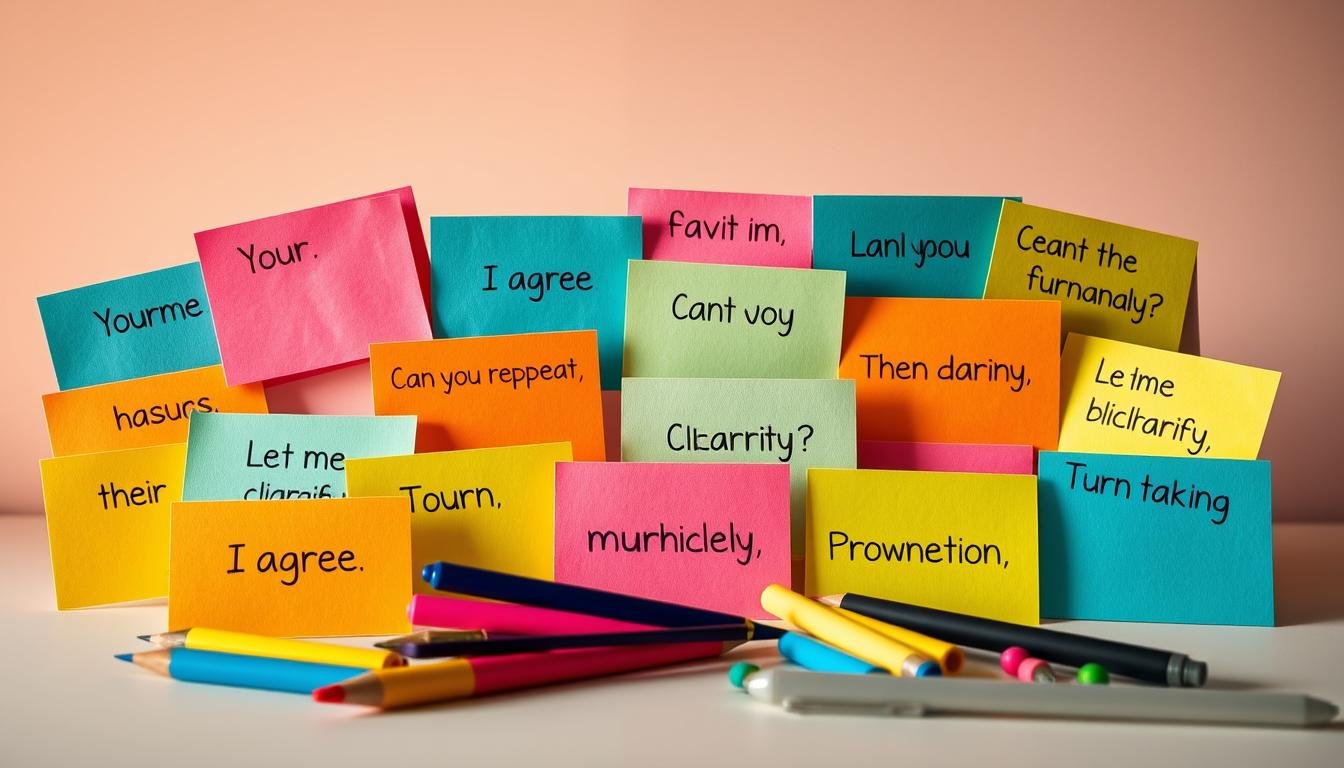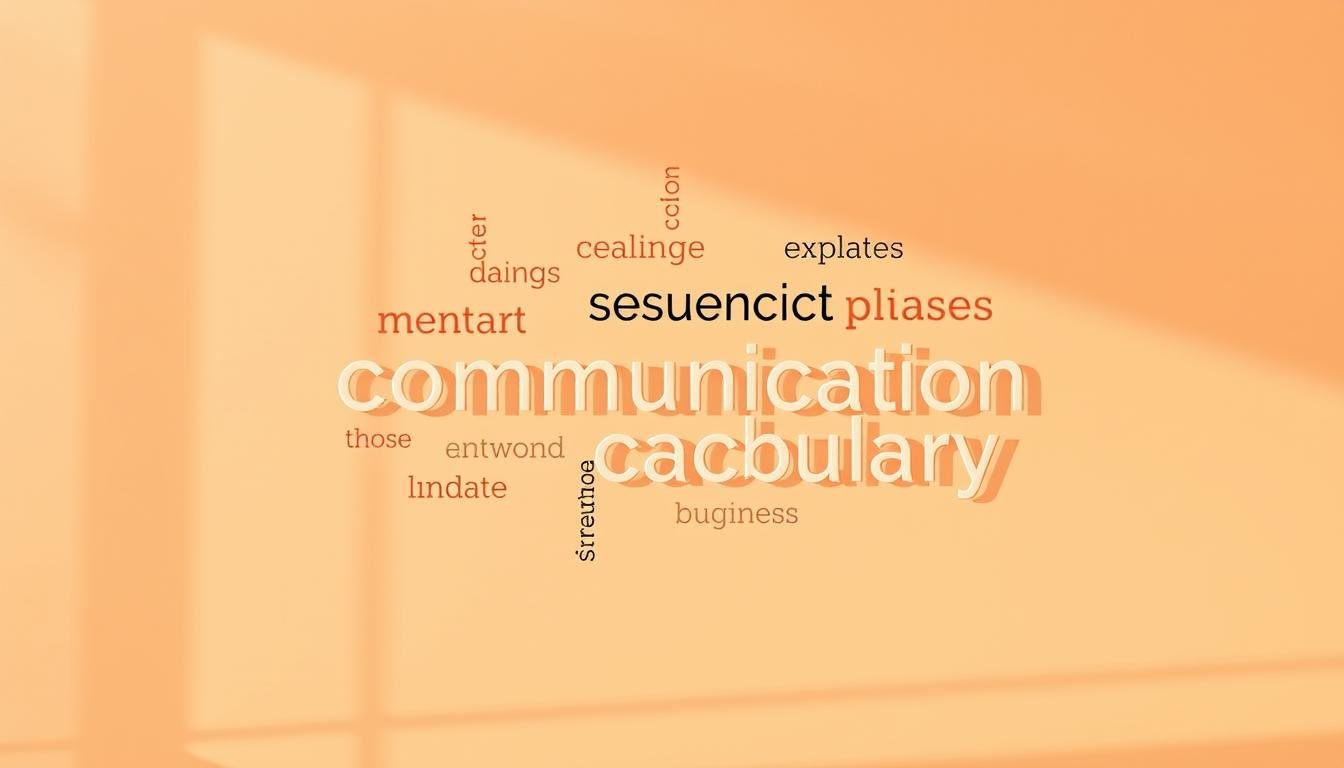Now Reading: The Vocabulary You Need for Seamless Turn-taking
-
01
The Vocabulary You Need for Seamless Turn-taking
The Vocabulary You Need for Seamless Turn-taking

The Vocabulary You Need for Seamless Turn-taking
Effective communication is key to any successful talk. Mastering the art of turn-taking is vital for clear messaging.
Imagine being in a chat where you want to speak up but can’t find the right words. This can cause awkward pauses or interruptions. It messes up the conversation flow.

Having the right vocabulary for turn-taking changes everything. It’s not just about talking; it’s about knowing when to overlap or yield. Using the right gestures and eye contact shows you’re ready to join the conversation.
Key Takeaways
- Mastering turn-taking vocabulary enhances communication effectiveness.
- Using the right verbs and nouns facilitates smooth turn-taking.
- Non-verbal cues like gestures and eye contact play a significant role.
- Understanding when to switch or overlap is crucial.
- Practicing turn-taking vocabulary improves conversational flow.
The Dynamics of Conversation Exchange
How we talk to each other is key to success in our interactions. It’s not just about sharing our thoughts. It’s also about making sure everyone feels heard and understood.
What Makes Conversations Flow Naturally
Good conversations happen when we listen well and think before we speak. We need to pay attention to body language and know when to let others talk. This helps keep the conversation smooth.
Deborah Tannen, a famous linguist, says, “Talking is like a dance where we all work together to understand each other.”
“The key to successful conversation lies in understanding the subtle dynamics at play.”
The Importance of Balanced Participation
Everyone needs to have a say in a good conversation. When we all get a chance to speak, the talk is more fun and useful. To make sure everyone gets a turn, we should use good conversation skills like interrupting nicely and listening well.
| Technique | Description | Benefit |
|---|---|---|
| Active Listening | Fully concentrating on what the other person is saying. | Improves understanding and shows respect. |
| Polite Interruption | Interrupting in a respectful manner to contribute to the conversation. | Allows for balanced participation. |
Learning these communication skills helps us have better and more meaningful talks.
The Psychology Behind Effective Turn-taking
Effective turn-taking is more than knowing when to speak. It’s also about understanding the psychological cues in social interactions. This knowledge is key for creating conversation strategies that work well and respect different cultures.
Cultural Variations in Conversation Patterns
Cultural norms shape how we take turns in conversations. Some cultures value directness, while others prefer politeness. Knowing these cultural variations helps us interact better in different social settings.
Social Cues That Regulate Speaking Turns
Social cues like eye contact, body language, and tone of voice are crucial. They help us know when to speak or listen. Understanding these cues is vital for clear communication.
Essential Vocabulary for Turn-taking: A Comprehensive Guide
Learning the right words for turn-taking is key to better communication skills. It’s vital in many settings, like meetings, casual chats, or presentations. Knowing how to take turns is crucial for a smooth conversation.
The right words help people switch roles, overlap in talks, and use eye contact and gestures. These actions make conversations flow better.
How Turn-taking Vocabulary Enhances Communication
Using the right words makes talks more natural and fun. Verbs like “to switch” and “to overlap” are important. They help manage who speaks next, avoiding confusion and letting everyone share.
| Verb | Usage in Conversation | Example |
|---|---|---|
| To switch | Changing the speaker | “It’s your turn to speak, let’s switch.” |
| To overlap | Speaking simultaneously | “Sorry to overlap, but I have a quick question.” |
Building Your Conversational Toolkit
Creating a strong conversational toolkit means learning more than just verbs. It’s also about nouns like “eye contact” and “gesture.” These non-verbal signs greatly affect how messages are understood.
For instance, keeping eye contact shows you’re engaged and ready. Using the right gestures can also make your message clearer.
By practicing these skills, you can get better at turn-taking. This will make your communication more effective.
Mastering Verbal Signals: Key Verbs in Conversation
In conversations, verbal signals are key to smooth talks. Learning these signals, especially key verbs, helps manage turns and talks well.
Verbal cues are vital for switching speakers. Knowing and using these cues makes conversations flow better.
To Switch: Techniques for Changing Speakers
The verb “to switch” is key in talks, as it changes who speaks or what’s discussed. Good switching involves using phrases and paying attention to body language.
Saying “May I add something?” or “I’d like to interject” shows you want to switch. This keeps the talk flowing well.
To Overlap: Managing Simultaneous Speech Effectively
Overlapping, or talking at the same time, happens often. It needs both words and body language to handle well.
Phrases like “Please, go on” or “No, no, please continue” help manage overlaps. They show respect for the other’s right to speak.
Strategic Verb Usage for Conversation Control
Verbs like “to interrupt,” “to interject,” and “to respond” are important for talk control. Using them wisely lets you share your thoughts while valuing others’.
For example, saying “I’d like to respond to that” can take control briefly. It allows for a fair share of ideas.
By getting good at these verbal signals and verbs, people can better their conversation skills. This leads to more enjoyable and effective talks.
Non-verbal Elements: Critical Nouns in Turn-taking
Effective communication in conversations includes many non-verbal elements. These are key for turn-taking. Eye contact and gestures are universal signals. They show when someone wants to speak.
Eye Contact: The Universal Turn Signal
Eye contact is vital for managing turns in talks. It shows who wants to speak next. This makes conversations flow smoothly.
Gestures: Physical Indicators of Speaking Intentions
Gestures also play a big role in showing who wants to speak. They can signal a need to speak, give up, or interrupt. This affects how the conversation goes.
Practical Applications of Non-verbal Cues
Using non-verbal cues like eye contact and gestures is crucial. They help in turn-taking in different situations. Knowing how to use them can make communication better.
Adding these non-verbal elements to your talks can make turn-taking better. It leads to more interesting and respectful chats.
Physical Actions That Facilitate Smooth Exchanges
Effective communication is key in many areas of life. Using physical actions helps make conversations flow smoothly.
To Clap: Attention-Getting Techniques in Groups
Clapping is a way to grab attention in groups. It can mark a change in conversation, add emphasis, or celebrate someone’s success.

To Lean: Body Positioning for Conversation Engagement
How you position your body matters in conversations. Leaning in shows you’re interested, while leaning away might mean you’re not.
Implementing Physical Cues Effectively
Using physical cues well means knowing the situation and who you’re talking to. In formal settings, it’s important to think about cultural differences and the right level of formality.
Transitional Phrases for Entering Conversations
Learning to join a conversation smoothly is a skill that gets better with practice. It’s not just about speaking your mind. It’s also about knowing when and how to step into a talk that’s already going on.
To get good at starting conversations, you need to know about speaking etiquette and turn-taking vocabulary. This means understanding the situation and using the right words to say you want to join in.
Polite Interruption Strategies
It’s okay to interrupt sometimes, but you have to do it nicely. Saying “Excuse me,” “May I add something?” or “If I may interrupt,” is a good way to join in without being rude.
Context-Appropriate Entry Points
How you start a conversation changes depending on where you are. In formal meetings, you might say “I’d like to add” or “That reminds me of…” to join in. At social events, saying “That’s really interesting” or “I’ve had a similar experience” works well.
| Context | Entry Phrases |
|---|---|
| Formal Meetings | “I’d like to add,” “Building on that,” “Relevant to the discussion” |
| Social Gatherings | “That’s fascinating,” “I’ve experienced something similar,” “That reminds me” |
Practice Exercises for Joining Discussions
Getting better at using transitional phrases takes practice. Try role-playing or joining discussion groups to improve. Watch how others start conversations and learn from them.
By practicing and mastering transitional phrases, you can get better at starting conversations. This will make you a better communicator overall.
Vocabulary for Turn-taking in Various Contexts
Learning the right words for turn-taking is key for clear talk in many places. Good conversation skills are important for easy chats in different spots.
Professional Settings: Meetings and Presentations
In work meetings and talks, the right words for turn-taking matter a lot. Saying “May I add something?” or “If I could interrupt for a moment” helps control the talk. Using these phrases wisely makes it easier to share ideas.
- Using polite interruption strategies
- Employing transition words and phrases
- Being mindful of non-verbal cues
Social Gatherings: Informal Conversation Management
At social events, managing chats is all about social interaction language. Knowing how to start or stop a talk is important. Saying “That’s an interesting point” or “May I join the conversation?” helps keep the chat flowing.
Digital Platforms: Virtual Communication Techniques
Online, we need special ways to talk. It’s important to use clear words in chats and know when to “unmute” to join a virtual talk.

By learning the right words for turn-taking in different places, we can get better at talking. Whether at work, with friends, or online, knowing how to take turns is key to good communication.
Yielding the Floor: Language for Inviting Others to Speak
When you’re in a conversation, it’s important to let others speak. This is called yielding the floor. It’s a way to show respect and let everyone have a say.
There are many ways to invite others to speak. You can say things like:
- “Let’s hear from you.”
- “What are your thoughts on this?”
- “Can you share your perspective?”
- “I’d love to hear your opinion.”
These phrases help create a space where everyone can contribute. It’s a way to make sure everyone’s voice is heard.
By using these phrases, you show that you value everyone’s input. It makes the conversation more inclusive and respectful.
Remember, yielding the floor is about creating a space where everyone can share their thoughts. It’s a way to build a more inclusive and respectful conversation.
Overcoming Common Turn-taking Challenges
## Overcoming Common Turn-taking Challenges
Effective conversation is key to good communication. Turn-taking is a big part of it. We’ll look at common challenges and how to beat them.
### Strategies for Dealing with Conversation Dominators
Conversation dominators can really block effective turn-taking. They talk a lot, leaving others little chance to speak. To handle this, we need strategies for fair participation.
One way is to interrupt politely. Use phrases like “May I add something?” or “What do you think?” to invite others to speak. This helps balance the conversation.
### Techniques for Hesitant Communicators
Some people find it hard to start or keep talking. We need to make them feel safe to join in.
Ask open-ended questions to get them talking. This boosts their confidence. Also, positive feedback and encouragement help them feel more at ease.
### Recovering from Awkward Interruptions
Awkward interruptions can mess up conversations. It’s important to handle them well. Say “Excuse me” or “Sorry to interrupt” to acknowledge the break.
This shows you’re aware and helps ease any tension. It lets the conversation flow smoothly again.
By using these strategies, we can tackle common turn-taking problems. This makes us better at talking and listening. We can then connect with others more deeply.
Practical Exercises to Develop Turn-taking Fluency
To get better at turn-taking, you need to practice. This section offers conversation scenarios and questions to help you improve.
Guided Conversation Scenarios
These exercises are for practicing turn-taking in different situations. Try talking with someone or a group. Notice how you and others take turns.
- Role-playing exercises: Practice conversations in different scenarios, such as ordering food at a restaurant, discussing a movie, or participating in a group discussion. Focus on how you and others take turns, and identify the cues that facilitate smooth turn-taking.
- Group discussions: Engage in group discussions on various topics, such as current events, hobbies, or interests. Observe how participants take turns, and analyze the factors that influence turn-taking.
Self-Assessment Questions
To check your turn-taking skills, think about these questions:
- Do You Find It Challenging to Identify the Right Moment to Speak? Think about your conversations and what cues help you know when to speak.
- In Conversations, Do You Typically Talk More or Listen More? Consider if you usually talk a lot or listen more. Think about how to balance both.
Do You Find It Challenging to Identify the Right Moment to Speak?
Think about what makes you decide to speak. Consider nonverbal cues, the situation, and the conversation’s flow.
In Conversations, Do You Typically Talk More or Listen More?
Look at how you communicate. Think about how to balance talking and listening.
Conclusion: Becoming Fluent in the Language of Turn-taking
Learning to take turns is key for good communication in many places. This includes work, social events, and online. By using the right words and conversation skills, you can make talking easier and more effective.
Knowing how to take turns well is important. It helps make conversations flow smoothly. Using words, body language, and actions can help you manage talks better.
To get good at taking turns, keep practicing. This will help you handle tough conversations better. With time and effort, you can become very skilled at talking with others.
FAQ
What is turn-taking vocabulary, and why is it important in conversations?
Turn-taking vocabulary helps manage conversation flow. It ensures everyone gets a chance to speak. This is key for clear communication and avoiding misunderstandings.
How can I improve my turn-taking skills in professional settings, such as meetings and presentations?
To get better at turn-taking in work settings, use the right words and body language. Say things like “Let me add to that” or “Can I share?” Use eye contact and gestures too. Practice these in different situations to feel more confident.
What are some common challenges in turn-taking, and how can I overcome them?
Challenges include dealing with people who talk too much and helping those who are shy. To solve these, use phrases that include everyone, listen well, and learn how to politely interrupt.
How can I use non-verbal elements, such as eye contact and gestures, to facilitate smooth turn-taking?
Eye contact and gestures are key for turn-taking. They show you’re ready to speak or pass the floor. Knowing how to use these can make your conversations flow better.
Are there specific vocabulary and strategies for turn-taking in digital platforms, such as virtual meetings?
Yes, digital meetings need special strategies. Use chat boxes, hand-raising tools, and clear signals to control the conversation. Knowing how to use these tools can make online talks smoother.
How can I encourage quieter participants to contribute to the conversation?
To get quieter people to speak up, use phrases that invite them to share. Listen actively to show you value their thoughts. Also, be mindful of how much you talk and make room for others.






























